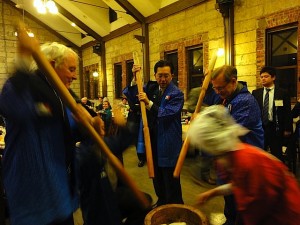Every season in Japan has its special treats that people look forward to, and the New Year is no exception. Mochi is not only a treat, but can be a fun activity as well. Though it can be found all year round, it is a traditional New Year’s food.
Basically, mochi is made from sticky rice. After the rice is cooked, it is pounded into a sticky paste, divided into individual serving sizes and shaped. Various toppings are available, and some people like it best in soup.
Of course, you can buy mochi already set for consumption, but one great activity is a “mochi-tsuki taikai” in which you make your own mochi along with family and friends. The Oshu International Relations Association (OIRA) held a “mochi-tsuki taikai” on 13 January for foreign residents with the help of Japanese supporters. Mochi master Kidao Tokui and his wife Misako brought their usu (traditional mortar) and kine (wooden mallet) to ASUPIA, a regional community center which is a home of OIRA. They started us out by pounding the rice. While Tokui pounded to a certain rhythm, his wife kept wetting the water and turning the rice. When you take a turn, be careful not to hit your partner’s hand!
People from various countries, Canada, China, Indonesia, Korea, Russia, Thailand, the U.K. and the U.S. took turns pounding the rice into Mochi. Those around cheerfully called out “Yoisho!”, a kind of rallying cry, each time the mallet came down. Children got their turns as well. When it was all over, there was a nice round ball of Mochi. Time to eat our efforts.
On the menu that day were two toppings and a soup. Anko is a sweet red-bean paste. It is traditionally used in Japanese confectionaries, made by boiling and mashing the azuki beans, seasoned with sugar. When I first tried Anko, I hated it, even spit it out of my mouth, so perhaps it is a bit of an acquired taste, but once you like, you love it. The other toppings were Kinako, which literally means “yellow powder” and is roasted soybean flour, and the third option available that night was a soup. The Mochi is balled and added to a zoni, a soup made with various vegetables. Zoni is traditionally eaten in New Year’s day as an auspicious food, and each region in Japan has its special recipe. Iwate’s zoni is usually made with julienne daikon radish and carrots, diced chicken and Japanese parsley. Everyone had a great time eating their work.
Once you get a taste for mochi, you can head on down to Ichinoseki in southern Iwate. Ichinoseki is known for its mochi culture, and one of the things they do to promote mochi is hold a “wanko mochi taikai,” a mochi eating contest. The term wanko (Iwate’s dialect meaning a bowl) comes from wanko soba, another delicacy of Iwate, best known for people trying to eat as many bowls of soba (buckwheat noodles) as one can in one sitting. Contests are held to see who can eat the most in a certain amount of time. Using that same type of competition, Ichinoseki held their Eighth Annual Wanko Mochi Taikai on 1 February. Participants are given a five-minute time limit to see how much mochi they can eat. Two members of the ILC Support Committee (ISC) participated this year for the first time. We were given a platter of nine bowls with mochi in them, with three different toppings. One was the above-mentioned anko. Shoyu, or soy sauce, was also on hand. Finally, there was zunda, or mashed boiled edamame soybeans. Past records for number of bowls eater were 122 for a team, and 74 for an individual. The daring duo from ISC fought hard to swallow down as many chewy morsels as they could to beat those records, but in the end we could only get 21 down all together, far short of record making.
Before I came to Japan I was one of the pickiest eaters around. I actually even had a hard time with anko. But thanks to the good food in Iwate, I have grown to love all kinds of food, especially that from here. When you come to help build or do research with the ILC, be sure to be open to new experiences. You are going to love it!



Recent Comments